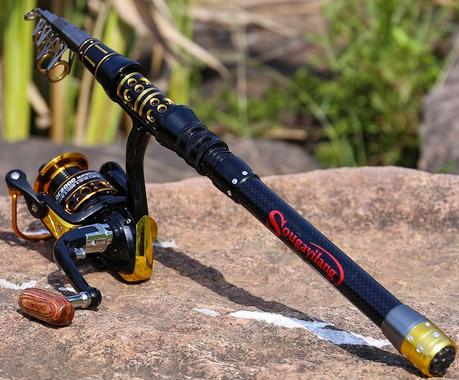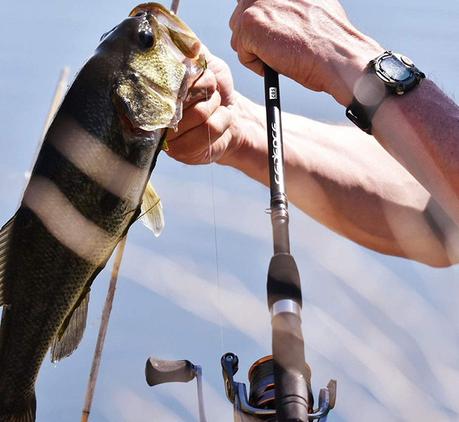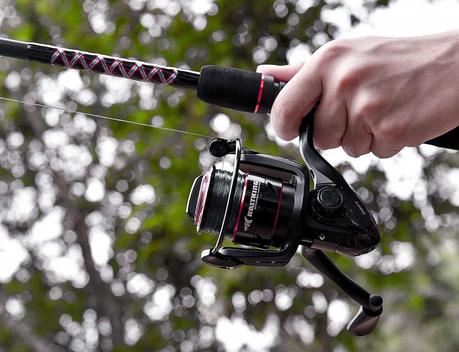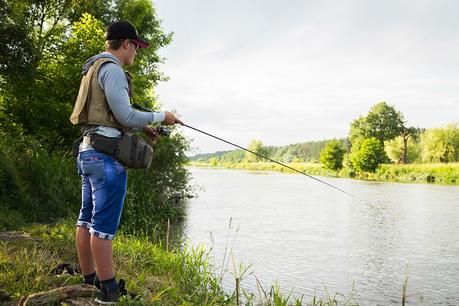
If you love fishing or come from a family of fishing enthusiasts, there are a lot of fishing gear that you can use. Catfish fishing rods are among them. Catfishing is a sport that requires not only patience but strength and skill as well.
This is because catfish are known to grow to enormous sizes and don’t make your job any easier when you are trying to catch them. For that reason, you need to use a premium fishing rod and reel combo available in the market even if it means spending a little extra.
At the end of the day, nothing ruins a good fishing trip like not being able to catch any fish because your fishing gear is not good enough. Catfish can be found in many freshwater bodies across North America especially and they are famous for their whiskers which are known as barbells.
There are several things that you need to keep in mind when you want to go catfishing. The first and probably the most important thing you need to know is that catfish rods come in different qualities in terms of power, length, and materials used to make them.
What Is a Catfish Rod
There are different kinds of fishing rods with casting and spinning rods being the most popular. When it comes to catfish rods, they can either be casting or spinning rods.
The difference between the two is that with spinning reels, a spinning rod is used while with a baitcasting reel with ergonomic design, a casting rod is used. As such a flexible, sensitive surf fishing rod can come as a casting or spinning rod. Catfish can grow to monstrous sizes and they are among the most strong of freshwater fishes.
Because of this strength, the catfish rod that you buy needs to be strong in such a way that the rod can bear the fighting strength of a catfish. As such, most fishing rods that you get tend to be strong, flexible and are very easy to use.
Benefits of Using Catfish Rods
Just like with the best spincast reel, certain benefits come from using catfish rods rather than a standard rod.
Durability
As mentioned, catfish are strong and because of this, the catfish rod you use must be able to handle this fighting strength. As such, catfish rods tend to be very durable compared to standard fishing rods which are very important for the sport.
Since you will be constantly competing with strong large fish that don’t shy away from a fight, then getting a rod that will last you for more than a couple of weeks will come in handy.
Power
Just like with durability, catfish rods are powerful to match the power of the fish they are supposed to catch.
Design
Compared to standard fishing rods, catfish rods tend to belong mostly up to ten feet. This makes it easier to control your catch as well as the length and accuracy of your cast. Most standard fishing rods are around six feet. A longer rod allows for easy management of the catfish since they are mostly found at the bottom.
How Do Catfish Rods Work

Catfish have been known to thrive in so many water bodies, from shallow warm ponds to fast-flowing rivers. While different species of catfish prefer different habitats, there are general areas where you can find catfish.
For instance, during the day, they can be found in muddy water areas like tributaries and their outflows. Since catfish can grow to tremendous sizes, you need a catfish rod that is strong enough to handle their fighting power.
Catfish rods work like standard fishing rods only that they are longer, stronger and more durable. They work by hooking to the fish whether at the bottom of the pond or in a muddy pool. Since catfish tend to put up a fight when you are fishing, the rods are striving enough to handle that.
Pros and Cons of Catfish Rods
If you have been using a standard rod to catch catfish, then you know why your fishing trips have not been as successful as you would hope them to be. Catfishing rods are strong and powerful to handle the strength of catfish.
Here are the pros and cons of owning a catfishing rod:
Pros
- Catfish rods are highly durable.
- They are powerful enough to handle the fighting power of catfish.
- They are longer than standard catfish rods since catfish tend to be found at the bottom of a water body.
- Some of them have an inbuilt GPS that allows you to create a bathymetric map of the angling area.
- Most of them are flexible to prevent damage to the rod.
Cons
- Some catfish rods are less sensitive to much smaller catfish bites.
- Some tend to be bulky.
- Some are too complex to be used by beginners.
Types of Catfish Rods
Catfish rods come in a variety of sizes, colors, and shapes. They can be made from different materials from e-glass to carbon and graphite and anything else in between.
E-Glass
E-glass material falls on the lower end of the spectrum. Fishing rods that are made from e-glass are quite popular since the material is not only strong but highly durable as well.
Such rods are strong and powerful but tend to be heavier and are less sensitive compared to other fishing rods. Most of the time, the e-glass fishing rod has a strong backbone that holds up well regardless of the situation.
Being powerful, strong and durable means that such fishing rods can handle some abuse. If you have a decent e-glass fishing rod, you can easily put some muscle to the fish and use the rod to land as well as manhandle it without fearing that it will snap.
For a long time, e-glass fishing rods have been the standard fishing rods for catfish lovers.
S-Glass
S-glass is similar to e-glass in a variety of ways but the former is more superior. It is stronger and has twice the modulus of e-glass making it even stronger. Additionally, it is lighter in weight which reduces the overall weight of the fishing rod considerably.
It has grown in popularity as anglers continue to come up with new catfishing techniques that require more sensitivity as well as a lightweight fishing rod that can be held for longer periods and still has the durability required in a fishing rod.
Since s-glass is stronger and more durable than e-glass, it is also more expensive and as such, very few manufacturers use it to construct fishing rods.
Graphite
Graphite rods are light in weight and are more sensitive. However, they are less powerful and don’t last you as long. A majority of the time, when you are looking for a catfish rod, chances are that the one you get will be a graphite rod.
Compared to other materials like e-glass, graphite is light in weight and also much more sensitive. This means that the rod can be held for longer periods since they are more comfortable.
In terms of sensitivity, graphite fishing rods allow you to feel much more such that you will feel every movement if a catfish is nibbling at the fishing rod. White e-glass is also sensitivity, the sensitivity is much better in a graphite fishing rod.
At the end of the day, however, graphite fishing rods are less powerful than e-glass ones. What this means is that, should you hook into a 50-pound catfish with an e-glass rod, you have better control of the fish in terms of putting pressure on it.
Carbon Fiber
Carbon fiber fishing rods are a step above graphite. They are the perfect combination of e-glass and graphite and offers the best of both worlds but higher on the price range. They are relatively new to catfishing and are only ideal for experienced anglers.
Composite
Composite catfish rods have been around for years, are expensive but for some reason are quite popular with catfish anglers. Composite rods such as the St. Croix Classic Cat whose production was stopped, used to go for over $200 and today they so sort after that a used one will cost you around $700 online.
This is because composite fishing rods are made from a combination of s-glass and graphite whose result is a more advanced fishing rod that is more powerful, durable and sensitive than standard catfishing rods. With composite fishing rods, you get the strength of an s-glass rod and the sensitivity and lightweight of graphite.
Catfish Species and Different Types of Catfish Rods

One of the biggest issues that most catfish anglers have is what material to choose when it comes to fishing rods. Do you go for e-glass, s-glass, graphite, carbon or the more advanced composite?
A large number of fishing rods are made from e-glass for a good reason. Such rods are cheap, easy to use while still maintaining the durability that is required in a catfish rod. They are also sensitive for smaller catfish and strong enough for larger catfish.
Channel Catfish
If you are planning on catching channel catfish and want to have a good number, the graphite fishing rod will work perfectly for you. This is because it is more sensitive than e-glass.
Blue and Flathead Catfish
If for some reason you are targeting blue and flathead catfish then you can use e-glass, s-glass or composite fishing rod. In such a case, you need the additional power and durability to handle larger fish and to hold up in different situations without snapping.
All Catfish Species
If you aren’t sure about the species of catfish that you are likely to encounter or are planning on fishing for all three species then an e-glass, s-glass or composite fishing rod will work perfectly for you.
At the end of the day, the fishing rod you choose will depend on the species of catfish that you are targeting, the size of the fish and the techniques that you will be using.
This is because the catfish anglers who target up to 3 pounds of catfish and is likely to hold the rod for almost the entire day has different needs from a blue cat hunter who targets monster catfish and leaves the poles in a rod holder.
How to Choose the Best Catfish Rod
Just like with a reel for a fly fishing, bass fishing rod that lasts for a very long time or braided fishing line with long casting ability, there are a few factors that you need to keep in mind when looking for the best catfishing rod.
Length
The length of a fishing rod plays an important role in not only the performance but how you use fly fishing wader. The rod length impacts whatever you do and a small difference in inches could make a considerable difference in your fishing experience.
A majority of catfish anglers are used to the freshwater rods that can be found in any local store that often measures 6 foot. The length of the fishing rod, however, will make an impact on your fishing technique at the end of the day.
Longer fishing rods most of the time offer better casting distance, as well as accuracy whereby the longer the rod is the further you can cast it and the more accurate the cast, will be.
A longer rod also gives you more control over the fish. If you are planning on catching 1 to 5-pound catfish, then a shorter rod will work for you but if you intend to catch larger fish, then you are better off with a long fishing rod.
With a shorter rod, you are likely to lose the casting distance as well as accuracy. While this may seem trivial, especially to a beginner, experienced anglers know just what a difference those few inches can make.
A longer and more accurate casting helps you catch more fish on the line than a shorter rod. Longer rods help you control the fish when you are reeling and landing them and the bigger the more crucial the length is. Normally, catfish don’t go down easily and they are likely to put up a fight and when you have a large irritated fish at the end of your line, then control is of the utmost importance.
Power
Rod power is usually the strength of your fishing rod. This power ranges from ultra-light to heavy. There are different species of catfish and each call for not only a different fishing technique but fishing rod too.
Most of the time, a medium (M) or medium-heavy (MH) action works for channel catfish while medium-heavy action will work for blue and flathead catfish.
Action
The rod action is usually determined by the position at which the rod begins to bend when there is a load that has been applied to it. In such a case, fast action rods tend to bend near the tip while medium and moderate action rods bend way deeper to give you more flexibility at the tip as well as the middle of the rod.
Slow action rods on the other hand bend throughout from the end to the handle which affects the flexibility of the fishing rod. At the end of the day, more action will mean less bending in the fishing rod.
What you will realize however is that most fishing rods will bend or flex at some point hence it’s up to you to determine what action you want based on the fish you will be catching and the technique you will be using.

Line Guides (Eyes)
Line eyes are something that a majority of catfish anglers don’t pay attention to but they are very important. Line guides are usually the round pieces mounted on the rod and run throughout its length.
Most fishing rods will have one line eye per foot. Cheaper fishing rods tend to have fewer eyes which is something you need to pay attention to when you are buying a fishing rod.
Line guides play an important role in the performance of the rod, its durability, and sensitivity. In terms of sensitivity, the line guide transfers vibration when a fish is nibbling in which case fewer line guides or those that are less than one per foot will make the rod less sensitive.
The line guides also distribute stress throughout the rod when a fish is fighting. Rods that have fewer guides are likely to break due to the stress. Line guides also assist in smooth as well as accurate casting where the more guides there are the better the casting and the accuracy.
At the end of the day, the number of line guides on the fishing rod is not a major concern when it comes to the quality of the rod. What is important and what you should pay more attention to is the material used to make the line guides where cheap fishing rods will always be made of inferior materials as a cost-cutting measure.
Most cheap fishing rods will have line guides made of materials like ceramic. While the ceramic inserts work just fine, at the end of it all, they are likely to get knocked off the fishing rod forcing you to repair or replace them altogether.
Handle
Another point of concern when it comes to fishing rods is the handle. Catfish rod handles are very different from those found in traditional fishing rods. Fishing rods covered with the cork that have short handles are the most common.
The major difference, however, other than the material of the handle is the length of the handle itself with catfish rods having the longest handles. Three main materials are used for catfish handles and they include foam, cork, and paracord.
Foam and cork have been on the market for years but cork has always been associated with quality rods. Most manufacturers however who make catfish rods, use foam rather than cork and there is a reason for this.
Foam
Foam handles are common in fishing rods, especially those that are catfish specific. Foam is comfortable to hold even for long periods and not to mention is more durable.
With a foam handle, you will never have issues with the handle being slick when it is wet or covered with slime. Foam handles are also more durable and don’t easily break down over time and they are also easy to clean.
Cork
While cork handles work just fine, they have a few issues that are a concern for many anglers. The biggest concern is that they get slick when they are covered with shad and catfish slime as well as other elements that you are likely to come into contact with when you are fishing.
Compared to foam, cork is also more porous and slime and other elements easily get caked down in the pores. As the handle continues to age, the pores become bigger which means more stuff inside them.
If you happen to fish with stink baits for channel catfish the cork handle poses another problem where the handle tends to get saturated with the bait. Perhaps the biggest issue with cork handles is that they are less durable in that the material weathers and ages poorly and has a tendency to crack over time.
Most of the time, taking the rod in and out of rod holder day in day out when you are catfishing will damage the handle but a majority of anglers are willing to overlook this for the comfort and feel that cork handles offer.
Composite Cork
This is a new material that came into the market a few years ago. Composite cork is usually a combination of cork and rubber which means that it offers the feel, look and performance of cork with the added durability, no grip slip and better long term use of rubber. Composite cork as such is more durable than traditional cork and foam and is also easier to clean.
Paracord
Over the past couple of years, paracord or parachute has made its way into the market and is now being used to make catfish rod handles. Such handles come wrapped with cordage and on the outside is a paracord that is often used on knife handles.
Paracord handles are more durable, never gets slick and provide texture to the handle of the fishing rod that adds to the comfort. The only downside with these handles is that there are grooves throughout the handle where slime and gunk cake up over time.
Paracord handles are not ideal for anglers that use already prepared baits since the handle gets caked up with stink bait which affects your fishing experience but you can still detect the location of fish with a fish finder to make things easier.
Casting Distance
The casting distance is determined by so many factors including the length of the rod as well as the number of line guides. Line guides are important in that they assist in “feeding” the line of the rod and help in smooth and accurate casting.
Cheap catfish rods have fewer line guides which is something that you need to look out for. More line guides mean smoother and more accurate casting.
The length of the handle also matters when it comes to casting distance and they are longer in catfish rods for a reason. A long handle, however, gives you better casting and more leverage with larger fish in that it allows you to hold the rod and control the fish regardless of the situation.
It also allows you to bring the fish off the bottom and manage them better when you are reeling them in and landing them. With a longer handle, it is easier to keep your hands on the handle and hold the fish when the situation calls for that.
Accuracy
The accuracy of your cast makes all the difference when it comes to the number of fish you are going to catch. Longer fishing rods usually offer a much better casting distance and in the process way better accuracy.
This is because a longer fishing rod allows you to cast far and more accurately which makes all the difference in your fishing experience. A more accurate casting also gives you better control over the fish.

Control Over Fish
At the end of the day, nothing ruins a good fishing trip like not being able to catch a single fish. Your control over the fish makes a whole lot of difference in this case.
The casting distance and accuracy will determine how much control you have over the fish. Usually, catfish are strong and will put up a fight when you are trying to catch them. What this means is that you need a fishing rod that is strong enough to help you reel them in and land them.
Weight and Sensitivity
Catfish are big mean fish that don’t go down easy. The weight of the fishing rod, therefore, needs to sustain the weight of the fish without snapping.
Additionally, sensitivity is very important when you are fishing since it allows you to know when a fish is nibbling at the line and it is determined by so many factors which include the length of the rod, the number of guides and the material used to make the fishing rod.
Circle Hooks
Having some flexibility at the tip of the fishing rod is important when you are fishing. Some movement at the tip of the fishing rod is important for instance because it provides you with information on what the fish is doing.
When fishing in shallow water, it is common for catfish to bite and run at the faster fishing kayak of premium quality as well. If the rod has some slight flex at the tip, you can easily see the rod slacking or straightening which indicates that there is a bite at the end of the fishing line.
The rod tip is also important when you are fishing with circle hooks as well. A rod that has a little bit of flex at the end doesn’t work so well with circle hooks since they work well with fishing rods that can bend and flex.
Reel Seats
Reel seats are most of the time overlooked in freshwater fishing. As mentioned when you are fishing for catfish, your rod is prone to abuse. In such a case, you reels seats need to be durable, heavy and capable of handling such abuse in case a big catfish happens to latch at the line.
Reel Seat With Lower Stop
With this, the upper part of the seat is fixed and the lower end tends to have a closing clip. Because of this, the seat can easily slide on a track to adapt to any reel hooking size.
Reel Seat With a Front Block
In such a reel seat, the reel needs to be inserted first into the lower seat. The upper part is then screwed to make way for the right positioning of the lifting equipment. The rod in such a case must be able to transfer cephalopods vibrations in the barrel and pick up prey quickly at the same time.
Screw Reel Seat
The screw reel seat is more common and it has an upper part that is fixed while the lower end is screwed to the reel block. The trolling rods usually use two rings that are interspersed with a membrane made of rubber which allows for exact fixing of the reel to the barrel.
Rod Tips
Rod tips are the last part of the fishing rod that is brightly colored on a catfish rod to stand out against the background such that you can see any movement at the tip.
Bright colors like yellow, green and orange are used moré often with some manufacturers even adding a glow in the dark element so that the rods can be visible at night. Their importance varies from one catfish angler to another and hence whether to have them is a matter of personal preferences.
Materials
The materials used to make the fishing rod are very important. The handle of the rod allows you to keep the barrel firmly secured so that it doesn’t slip or rotate.
Cork is the most common type of material used to make fishing rod handles especially those used for freshwater fishing. Spinning rods with neoprene, on the other hand, are used for sea fishing because the material is resistant to corrosion. Today, almost all fishing rods are made of carbon fiber because it is stronger and more flexible replacing traditional glass fiber.
How to Use a Catfish Rod

Catfish usually are curious which often results in a few bites. Using a catfish rod, however, is no different from using a traditional fishing rod or a fly fishing rod with precise casting.
Since catfish love lurking at the bottom of a water body, a slip sinker rig is the most ideal set up to catch them since it’s not only easy to use but very versatile.
Step 1 – Choosing the right fishing rod and line
When catfishing, the size of the rod is determined by the size of the fish that you are going to be catching. For fish that are under 20 pounds, a six-foot rod with a10 ponds test line works best while those over 20 pounds are better off with a seven-foot rod that has a 20-pound test line.
Step 2 – Buying fish hooks and bobbers
A majority of stores carry starter tackle boxes that have a range of supplies to get you started. If you will be catfishing you need sharp fish hooks as well as bobbers.
Step 3 – Experiment with different kinds of baits
There are catfish anglers who swear by a specific kind of bait but the truth is that catfish eat different things. If you are a beginner, take with you different kinds of baits to find out what catfish in that region like to eat.
Step 4 – Choose the right bait size
If you know that there is a chance that you will be catching a 50-pound catfish, then you need a larger bait since smaller baits will get stolen off the hook.
Step 5 – Keep the bait fresh
Catfish are not known to eat fish that has been left sitting out for long. As such, ensure that you store your bait in a cooler so that it is fresh when you use it.
Step 6 – Start fishing
Now that you have everything you may need, you may start fishing by casting the fishing rod into the water and waiting for the catfish to nibble at the bait.
How to Clean a Catfish Rod
Taking care of your catfish rod is one way of ensuring that you get value for your money. In whatever you do, don’t ever let the rod strike a hard surface. This is important if your fishing rod is to last you for a long time.
If you leave it lying on the ground, chances are that someone will step on it forcing you to either repair or replace it with a new one.
Additionally, to avoid accidental breaking of the rod, make a point of carrying it horizontally when the tip is facing backward rather than forward. When you are transporting your fish rod also, ensure that you don’t place it where it can be damaged like the back of a crowded trunk.
Step 1 – Use warm water
To clean your fishing rod, use warm soapy water and a sponge.
Step 2 – Rinse off
Use hot water to rinse off the rod and then leave it on a rack to dry completely.
Step 3 – Remove dirt and grime from the guides
Take a q-tip to ensure that all ferrules and guides are free of grime and dirt.
Step 4 – Don’t lean it again a wall for a long time
This is important to avoid bending the rod unnecessarily which can affect its durability.
Catfish Rods vs Catfish Poles
There is a common misconception that catfish rods are the same as catfish poles especially among beginner anglers but the two are very different. For one, a fishing pole is usually made of naturally occurring elements like reed, bamboo, and cane and has a line that is directly tied to the pole.
A catfishing rod, on the other hand, is made from materials like graphite, carbon fiber, fiberglass or a combination of the said materials.
Does More Spending Mean More Quality
When it comes to catfish rods, more spending does mean more equality. Catfish are usually big and they are known to not go down easily hence you need to prepare for a fight.
For this reason, the kind of fishing rod that you have needs to be strong enough to handle their fighting power without snapping.
Most anglers who decide to target catfish often go out to the local bait and tackle shop and buy the first fishing rod that they find that has catfish on it. Such fishing rods come from a variety of manufacturers and they come in different sizes and colors.
However, a vast majority of catfish rods that you will find in the market are not in any way suitable for catfishing. They are heavy, poorly built and don’t have the essentials that are required to successfully catch catfish.
There are so many factors that determine the fishing rod that you will buy and they include the length of the rod, power, action, line guides, type of handle, casting distance, material, accuracy, control over fish, weight and sensitivity, circle hooks and reel seats.
The number of line guides most of the time is not a major concern when you are looking for a quality fishing rod. At the end of the day, however, cheap rods have fewer guides but the most important thing to consider is the material.
In an attempt to cut production costs, some manufacturers use inferior materials like ceramic to make line guides which affect the durability of the rod. While ceramic inserts work just fine, in the end, they will wear out quickly forcing you to do some repair or replace them altogether.
Cheaper models are also less sensitive which makes it hard to know when a catfish is nibbling at the bait. A more sensitive fishing rod, while it may be expensive, takes your fishing experience to a whole other level.
Additionally, cheap fishing rods also tend to bend easily which accelerates the wear and tear forcing you to spend even more replacing the rod in the end.
Do’s and Don’ts With Catfish Rods
- Do experiment with different types of bait since catfish eat different things.
- Do use the right bait size for the right size of fish if you are to succeed in your fishing.
- Do carry the fishing rod horizontally with the tip is facing backward rather than forward to avoid breaking it.
- Don’t leave the catfish rod leaning against a wall for an extended period as this may cause it to break which affects its durability.
- Don’t ever let your fishing rod strike a hard surface as this may result in breakage.
FAQ About Catfish Rods

How long should a catfish rod be?
The length of a fishing rod affects its performance and how you use it. Most anglers often use the six-foot freshwater fishing rods that can be found in any local shop. There are however advantages to using a longer rod especially if you are targeting catfish.
For instance, if you will be fishing from a boat, you can easily get closer to your target area which allows you to cast shorter distances which eliminates the need for a longer rod. Shore fishing, on the other hand, is different in which case the technique you use may require you to rely on a longer fishing rod.
To be on the safe side however, for catfishing target fishing rods that are seven to ten feet long since they are more versatile.
Can you use a catfish rod for salmon?
The simple answer is yes, as long as the bait size matches the size of the salmon.
Who makes the best catfish rod and where to buy it?
In my opinion, Okuma makes the best catfish rod if their Okuma Battle Cat Catfish Spinning Rod is anything to go by. The rod is strong and durable and comes with double-footed stainless steel guides, a cork rear grip, and the EVA foregrip. You can buy the rod on Amazon and have it shipped to where you rare.
How to make catfish rod holders?
You can make catfish rod holders from an aluminum rod. Start by sticking the rod through the vice jaw so that it can dig into the sand. Afterward, clamp it tight and bend it slowly to 90 degrees then grip the end of the rod and bend it horizontally until it forms a circle.
Take it out of the vice and then turn it 90 degrees and clamp the other end back in. Using a hammer, hit the base of the curved section until it is bent enough such that you end up with a straight length of Al+ with a loop to stick your rod through.
Put the end of the rod in the vice and bend it horizontally and then un-tension the vice, pull the rod up and retighten it and then hammer the next part to start the circle.
How to build a catfish rod?
The easiest and best way is to find a bamboo tree or patch and then cut a five to six-foot-long piece. Get a fishing line or something that resembles a string but thin yet strong and tie it to the end.
How to rig a catfish rod?
You can use a three-way rig with a 20-pound test line and 17-pound test leader. Secure a two to four ounce a bell sinker to one rig of the barrel or the bottom ring of a three-way swivel with a six-pound test line.
Can you surf fish with a catfish rod?
Yes, you can successfully surf fish with a catfish rod.
Conclusion
If you have been fishing for a while and are now thinking about targeting catfish, the first thing you need is to get yourself a quality catfish rod. Avoid going for cheap fishing rods that are not strong and will snap easily because they can’t handle the fighting power of catfish. Consider factors like length of the rod, power, action, line guides, type of handle, casting distance, material, accuracy, control over fish, weight and sensitivity, circle hooks and reel seats when you are buying a fishing rod.
Photos from: habrda / depositphotos.com, stetsik / depositphotos.com and aallm / depositphotos.com.

